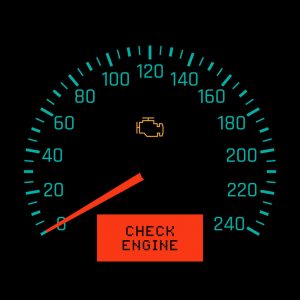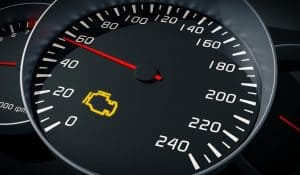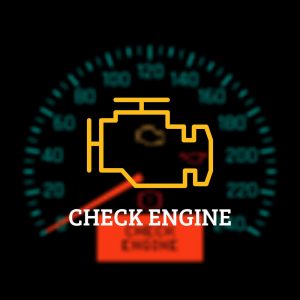The check engine light remains a scary signal that many car owners never wish to see. This signal is usually connected to your car’s onboard diagnostics, lighting up whenever something is wrong with the complex collection of sensors and components. The electron control system issues are portrayed in ‘trouble code’ for determining the source of the complexion.
Once you see this check engine sign, your foot will automatically shift from the fuel pedal to the brake pedal. This is because this sign is dangerous to both our eyes and minds, so the best thing is to slow down and get the car diagnosed. This article will therefore try to educate on the consequences of driving with a check engine light on.
Check Engine Light On? What’s the meaning?
It’s possible to get a dread feeling if the check engine light is on. You will start asking yourself if something is about to happen or how much will I spend for replacement or repair? Let’s exploit the meaning of the signal, the harms are, and what can be done to contain the situation:
The check engine light comes when your car’s computer believes there’s something wrong with the vehicle’s emission control system. When this happens, the computer of your car stores some diagnostic trouble codes. The computer stores the codes even after the signal goes out. So, to address this issue, your mechanic or you must use an OBD-II Scanner to resource the codes.
Light on engine issues sometimes implies that your car’s emission control system is problematic, and your car pollutes the environment. Therefore, you can drive with the car engine checked light on, but not on highways. Get your car fixed. However, sometimes drivers confuse the service light and check engine light; don’t confuse them.
These lights show up when it’s time for regular service. Such issues are sometimes triggered by gasoline gallons, distance coverage, among other vehicle-use measurements. You should therefore take the vehicle to the professional mechanic for a checkup.
What you should do when the check engine light is on
Not all these check engine light signals are developed equally. Below are some of the common conditions and their meaning:
1. The check engine light illuminates only in specific conditions
The signal can come on when driving on city roads and goes out when driving along the freeway. This may imply that your car is only affected by city driving environments. It might also flicker consistently. It would help if you were careful to determine when and where the check engine light comes on.
Once you spot any difference, it’s always advisable to slowly drive your vehicle to the nearest automobile. However, sometimes this signal won’t affect the performance of your car; drive home. But you should not ignore the check engine light issues; seek the help of an expert and have checked.
Driving with the check engine light on is, therefore, dangerous because you expose your car to the risk of not starting or dying.
2. The check engine light illuminates and stays on
If you don’t notice performance or driving problems yet the check engine is constantly on, the emission controls system might be having a permanent fault. Nowadays, cars are computerized, and if the master computer senses this issue, it switches your vehicle to what we call “limp-home mode.”
The computer does so as it tries to contain the emission control system problem. Your vehicle will run on lower gears; it’s disgusting, and you won’t get away with it. Drive home slowly and let an experienced mechanic check it.
3. Check engine light stays on, accompanied by performance problems
There might be a serious problem with an important component of the engine management and emission control system in such scenarios. This might be calling for a system or component from your car to fully run. Therefore, I cannot advise you to drive with such a vehicle; it’s dangerous and unsafe.
Forcing the vehicle may make it stall out or stop at any moment. Assume it’s in the middle of the forest; it’s hectic, and I am sure no one is ready for this. The earlier, the better; have the car checked. Sometimes it’s advisable to slowly back at the roadside and tow the right place for checkups and repair.
4. While driving, the check engine light illuminates and steady blinks in a pattern
You should not confuse a flicker and the steady pulsing check engine light. This signal usually involves one or more flashes in a second. This problem may happen when you accelerate the vehicle; the check engine light may flash or steadily stay. Please don’t ignore this issue; it’s more serious.
If you spot such flashes, there might be a serious fault with the emission control system. This problem makes the car engine misfire, damaging the catalytic converter every time the check engine light illuminates/flashes. This is the worst stage I am sure you would wish to get experience.
The catalytic converter might overheat to the extent of glowing read, and sometimes it can lead to a fire outbreak on the vehicle’s underside. If you experience, slow down and pull over. Ensure the place is on the roadside and is safe before calling for towing services. The vehicle should be towed directly to the nearest automobile for diagnostic and repair.
You might be read also: Driving on ice tips
Determining if it’s safe to drive with check engine light on
From the above sector, you can realize that it’s possible to drive with the check engine light on, but this depends on the vehicle’s performance. Besides, it depends on the main cause of the check engine light on the issue. However, it’s advisable to get your vehicle inspected sooner as possible once you see this signal.
If you notice this issue while driving, use the following steps to determine whether it’s safe to drive home, garage, or call for towing services.
1. Check if the issue needs immediate attention:
Not only can the engine issue lead to check the engine light on. The car’s dashboard may sometimes imply overheating issues or low oil pressure. The best thing to do here is to slow down and switch the engine as much as possible if you illuminate these lights.
Occasionally, some car models may portray a red check engine light for warning, while the yellow one for investigation. Immediately stop once you see a red check engine light on and drive slowly home or to the garage for inspection.
2. Slow down and reduce load
If your vehicle is loaded, offload some luggage once you notice some car’s performance problems. Reducing loads is essential to avoid pricey repairs.
3. Check the vehicle’s gas cap
This happens mostly when the check engine light illuminates shortly after refueling. You need to slow down and the gas cap state; ensure it is firmly in place. This action solves the problem oftenly, though it may require you to make multiple engine restarts to reset the light.
The light illuminates after suspecting a leakage in the car’s evaporative emissions system. However, some of the newer car models come with their specific gas-cap indicator.
FAQs about heck engine light on:
- Will the check engine light go out on its own?
No, this light will go out once the actual issue is addressed. Otherwise, expect to drive with, but don’t ignore it. Addressing the issue will be handling the vehicle’s computer and cleared from memory. Once the computer detects that there are fewer faults, the light will go off. But, if the situation is not completely handled, the check engine will reappear after some time.
- How urgent can be the check engine light on the issue?
This usually depends on how difficult the situation is. The above discussion explains when to drive slowly in the garage or home and when to get your car towed to the nearest garage. So, you need to inspect and observe the signal’s status; if it shows some danger, pull over.
Thank God some newer cars come with red check engine light for warning and yellow for inspection.
- How can I diagnose the check engine light on the issue in my car?
It’s a bit challenging to search for the problem if you don’t know exactly its source. Determining how difficult the situation is should be based on the car’s performance; if you experience some unusual behavior with your car while driving, pull over.
Some experts recommend using an OBD-II Scanner to diagnose the issue with your vehicle. This is an easy and reliable way of determining and solving the check engine light on the issue.
Conclusion
Don’t panic after seeing the check engine light on the issue, but I don’t mean that you should ignore the problem. This warning signal is dreadful, and the car owner may start thinking of the repair cost. Yes, you should be worried because there might be something wrong with your car emission control system that needs to be addressed based on the vehicle’s performance.
More about Is it safe to drive with the check engine light on; You should watch this video below;
